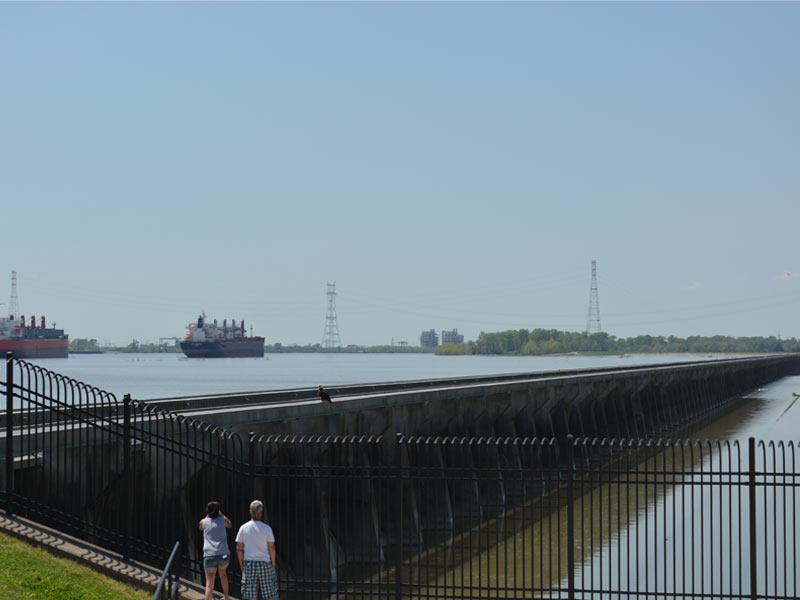Tulane research confirms river diversion can limit impacts of Bonnet Carré Spillway openings
Responding to an unprecedented number of Bonnet Carre Spillway openings since 2018, scientists with Tulane University and the Environmental Defense Fund are hoping a new study will demonstrate to federal and state decisionmakers how upriver river diversions could reduce spillway openings and their associated environmental damage.
The study, titled Utilizing Upper Diversions in River Water Management, is the second phase of a 2020 report conducted by Tulane to demonstrate the potential benefits of upper river diversions.
In the first phase, researchers used digital modeling to show how the Union Freshwater Diversion and the Ama Diversion could improve river management and reduce the volume of water flowing through the spillway. The second phase used a basin-side analysis to explore different aspects of the spillway’s influence, quantify the potential benefits of using the upper river diversions and examine the impact on water quality and the potential environmental benefits.
“As climate change delivers more water to our region, the results of this study highlight a viable win-win solution for both Louisiana and Mississippi.”
Devyani Kar, senior manager and scientist with the Environmental Defense Fund
Tulane Professor Ehab Meselhe and his team developed a three-dimensional model to represent the effects of flooding, sediment transport, water quality effects and salinity dynamics from the use of the spillway. Meselhe’s team includes Kelin Hu, a research assistant professor, and Laura Manuel, a PhD student.
The study confirms what scientists have long believed — that using upper river diversions will reduce the magnitude and duration of spillway openings, which in turn will improve the effects on wildlife, seafood productions, coastal communities and economies.
“The results of this study are very promising,” said Meselhe, a professor in the Tulane Department of River-Coastal and Science Engineering who helped build numerical models used in Louisiana’s 2012 and 2017 Coastal Master Plan. “They show the opportunity to leverage these projects to benefit both Louisiana, through restoration and conservation of vital wetlands, and Mississippi, by limiting the flow of water through the Bonnet Carré Spillway and resulting increases in salinities across the Pontchartrain Basin and the Mississippi Coast.”
The report was commissioned by the Environmental Defense Fund, a nonprofit organization working on the ground in Louisiana as part of a coalition of groups called Restore the Mississippi River Delta. The goal of the group is to advance coastal restoration solutions to protect the region’s people, wildlife and jobs in the face of land loss and climate change.
“As climate change delivers more water to our region, the results of this study highlight a viable win-win solution for both Louisiana and Mississippi,” said Environmental Defense Fund senior manager and scientist Devyani Kar. “Federal and state leaders have a tremendous opportunity to use projects like the Union and Ama Diversions to restore hundreds of thousands of acres of critical wetlands in Louisiana, while also reducing the impacts of the Bonnet Carré Spillway to our neighbors in Mississippi.”
The Bonnet Carré Spillway allows flood waters from the Mississippi River to flow into Lake Pontchartrain and then into the Gulf of Mexico. It has been opened 16 times since its construction in 1937 — four times since March 2018. In 2019, an unprecedented volume of water was released through the structure, nearly 31 million acre-ft (which means that 31 million acres were covered with 1 foot of water).
Opening the spillway relieves pressure on levees that protect about one million people in southeast Louisiana from flooding and allows the U.S. Corps of Engineers to maintain river stages and regulate river flow downstream from the spillway.
However, opening it also impacts the Mississippi Coast, bringing excessive water flow and changes in salinities. Meselhe said there are better solutions to managing this excess water and potentially limit use or duration of the spillway, while also reducing the risk of floods and benefiting wetland restoration benefits.
Those solutions are in the form of river diversions, which the state of Louisiana endorses through its Coastal Master Plan. Such diversions are designed to divert freshwater, sediment and nutrients to help restore and sustain wetlands in the face of sea-level rise and climate change. Specifically, the Ama Sediment Diversion will divert sediment, nutrients and freshwater from the Mississippi River to existing wetlands in the upper Barataria Basin, while the Union Freshwater Diversion will move freshwater from the Mississippi River into Maurepas Swamp near Burnside.
The report includes several recommendations, including continuing to improve the predictive quality of the modeling system and communicate with stakeholders about the efficacy of implementing the diversions and the potential benefits on the ecosystem and local communities.

